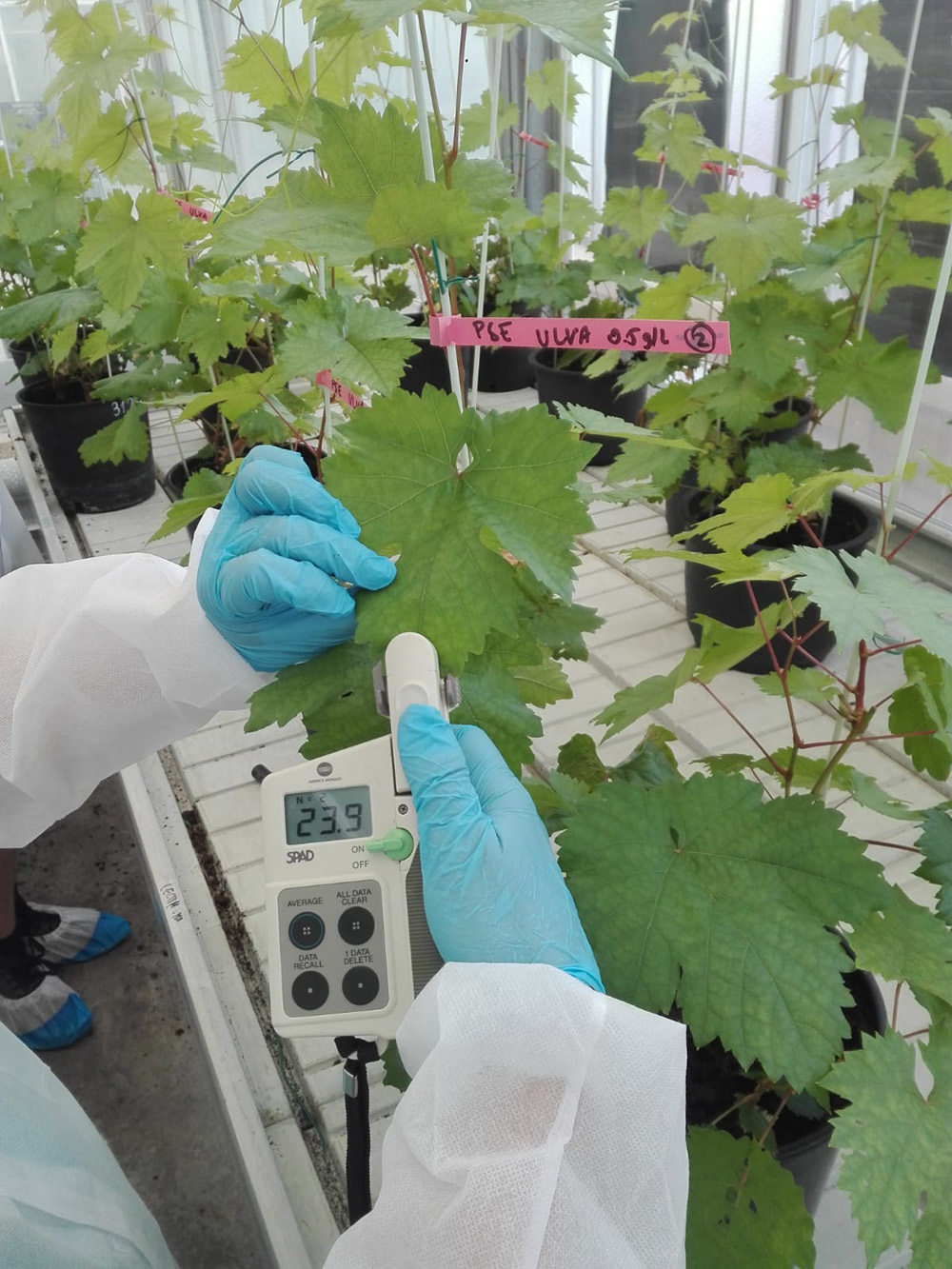In the quest for ecological strategies to reduce or replace the most common chemical treatments in viticulture, the SEAWINES project, led by the University of the Basque Country (UPV/EHU) and IFAPA, has shown that a type of invasive seaweed activates and enhances the defence mechanisms of the vine. While more research is needed to corroborate what has been observed in the field testing, the team is optimistic about the future of the seaweed extract.
Invasive seaweed extract stimulates vine defence mechanisms
A study by two UPV/EHU groups reveals that it is possible to contribute to eliminating invasive algae and reinforcing vineyards at the same time
- News
First publication date: 26/05/2023

The European Commission has set itself the target of a 50% reduction in pesticides used in agriculture by 2030. These products are also known to be particularly abundant in viticulture given the frequency of infections by organisms as diverse as downy mildew and powdery mildew, both of which are caused by fungi. With the aim of “seeking a strategic, ecological alternative to combat these two fungi, a year ago we launched the SEAWINES project”, said Iratxe Zarraonaindia-Martínez, Ikerbasque research associate in the UPV/EHU’s Department of Genetics, Physical Anthropology and Animal Physiology.
The project aims to use marine macroalgae. The use of algae in agriculture has become increasingly common in recent years, as it has been shown to benefit crops in areas such as seed germination, plant growth and health, water and nutrient uptake. In the SEAWINES project, the biostimulant and fungicidal effects of two algae are being explored: Ulva ohnoi, whose potential against fungi is already known, and the invasive seaweed Rugulopteryx okamurae, which originates from Asia and is widespread along the Mediterranean coast. The protective effect of the latter “has not been analysed to date, but numerous studies are underway to examine its uses or applications. In fact, every year hundreds of tonnes of seaweed are extracted from the Mediterranean, and it would be very interesting to take advantage of it all in some way”, explained the researcher.
“Our commitment has been to test the capacity of some extracts of these algae to activate the defence mechanisms of plants, as an alternative to pesticides, so that the plant is stronger when attacked by a pathogenic fungus,” specified Zarraonaindia. Firstly, the study was carried out in greenhouses under controlled conditions. Specifically, they treated grapevines of the Tempranillo variety in the greenhouses of Neiker, the Basque Institute of Agricultural Research and Development, by impregnating their leaves with various seaweed extracts: two from Ulva and two from Rugulopteryx were tested. Some plants, the control samples, received water alone.
Following the treatments, leaf samples were taken and numerous analyses were carried out to analyse the effect of each treatment. The researcher summarised the findings thus: “The most positive results were obtained with one of the extracts produced from the invasive alga Rugulopteryx okamurae. After treatment with this extract, we saw how there was an increase in the expression of resistant genes and in the activity of antioxidant enzymes in the plant, among other things. In the microbiota on the leaf surface we also saw that some fungi that help the plant in biological control are more abundant on the plants that received the Rugulopteryx extract.”
Zarraonaindia was not surprised by the results. “Ultimately, as it is an invasive species, it is to be expected that it has capabilities or qualities that help it to thrive and also to displace other species so effectively.”
Confirmation of results under real conditions
The researcher regards the results obtained as “exciting”, although she is aware that they are “only the first results”. SEAWINES is a three-year project and in order to obtain as complete a measurement as possible of the potential of the invasive algae, work has already begun in field experiments to confirm the results obtained under greenhouse conditions: “We will be testing the algae extracts in vineyards in Jerez and La Rioja under local conditions. We will also be monitoring the impact across the stages of winemaking, in other words, to see the effect these treatments have on grape and wine quality, as well as on the biostimulation and antifungal effect they produce,” she said.
“We are looking forward to seeing how useful the Rugulopteryx algae may be. It would be great to be able to remove it from the environment and use it to strengthen viticulture; that would be a good example of the circular economy,” she concluded.
Additional information
This is the first scientific study to be published on the results obtained in the SEAWINES project, funded by the Ministry of Science and Innovation and led by the UPV/EHU, together with IFAPA Rancho de la Merced de Jerez (Andalusian Institute of Agricultural, Fishery, Food and Ecological Production Research and Training). As regards the UPV/EHU, researchers from the Department of Genetics, Physical Anthropology and Animal Physiology (the Genomics and Applied Bioinformatics group) and from the Department of Plant Biology and Ecology (FisioKlima-AgroSosT group) are working on the project. In addition to the above, researchers from Neiker's Plant Production and Protection Department, the Institute of Vine and Wine Sciences (ICVV) and IFAPA Rancho de la Merced are also taking part in the SEAWINES project.
Bibliographical reference
Iratxe Zarraonaindia, Enrico Cretazzo, Amaia Mena-Petite, Ana M Díez-Navajas, Usue Pérez-López, Maite Lacuesta, Eva Pilar Pérez-Álvarez, Belén Puertas, Catalina Fernandez-Diaz, Nadia Bertazzon, Emma Cantos-Villar.
Holistic understanding of the response of grapevines to foliar application of seaweed extracts
Frontiers in Plant Science
DOI: 10.3389/fpls.2023.1119854
Photo captions (Source: SEAWINES)
Vineyard: Rancho de la Merced vineyard, IFAPA Institute (Jerez de la Frontera, Cádiz), where the impact of the Ulva and Rugulopteryx extracts on the Tempranillo variety is being tested.
Measuring: Measuring the amount of chlorophyll in the leaves in the Neiker greenhouse (Arkaute) to determine the stress levels of the plants.
Algae harvesting: A researcher from IFAPA Rancho de la Merced harvesting Rugulopteryx seaweed in Algeciras.



